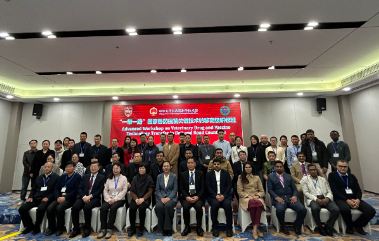BEIJING, DEC 23 (DNA) — “Collaboration with China within the framework of the Belt and Road Initiative (BRI) is crucial for advancing Pakistan’s veterinary technology sharing, knowledge exchange, and best practices in various fields, including vaccine development, production, and quality control.”
This was stated by Ms. Afifa Shajia, Education Attaché at the Embassy of Pakistan in China, during the opening ceremony of an advanced workshop on veterinary drug and vaccine technology transfer for BRI countries, held from December 20th to 31st in Beijing, according to Gwadar Pro.
The workshop, chaired by Prof. He Cheng from the College of Veterinary Medicine at China Agricultural University, aims to build a coordinated response among BRI countries to secure livestock health and industry stability.
“The workshop seeks to explore the needs of the livestock industry in BRI countries, discuss the potential for Chinese veterinary drugs, vaccines, and production technologies, and analyze veterinary drug and vaccine regulations across China and BRI countries to enhance regulatory alignment,” said Prof. He.
Key topics covered during the workshop include establishing a sustainable veterinary medicine and vaccine network among BRI countries, exchanging and promoting technology transfer in veterinary medicine, vaccines, and diagnostics.
Participants also discussed understanding animal epidemic diseases, market trends, improving control measures, contributing to the animal surveillance network, and collaborating to detect the prevalence of major animal diseases and reduce cross-border infections through training programs and key-lab alliances.
Additionally, participants will visit biotechnology enterprises in Beijing and Inner Mongolia for exchanges and interactions. Ms. Shajia further emphasized that joint research and development is another crucial area requiring immediate attention. “Pakistan is diligently working on infrastructure development, and we seek support for upgrading our laboratories and establishing modern production facilities within the country.
By tapping into Chinese expertise and resources, Pakistan stands to significantly enhance its livestock sector,” she said, adding that the workshop represents a positive step forward. The workshop, sponsored by the Ministry of Science and Technology of China and organized by China Agricultural University and the China Veterinary Medicine Association, attracts around 80 government representatives, experts, scholars, and entrepreneurs from China, Pakistan, Bangladesh, Cambodia, Iran, and Russia.
During the training session, Dr. Muhammad Mohsin Kiani, Sector Specialist for Livestock and Security at Pakistan’s Planning Commission, shared investment opportunities in the animal industry and vaccines under the China-Pakistan Economic Corridor (CPEC) framework in Pakistan.
“Livestock is crucial to Pakistan’s agricultural sector, which is the backbone of the country’s economy. There is great potential for the development of genomic testing technology in Pakistan, industrial-scale feedlots for beef exports, commercial shrimp farming for export markets, and farm mechanization in the livestock sector,” he noted.
Muhammad Irfan Ghazi, CEO/President of Ghazi Brothers, shared insights into the market demand and sales model for veterinary vaccines and medicines in Pakistan. With about 20 years of collaboration with China, he highlighted China’s vast consumer market and fast-growing technology. “China has emerged as a pivotal partner in boosting our veterinary sector, ultimately leading to a surge in exports,” he said.
“The expertise and resources shared during this workshop will further strengthen our ties and help improve the health and productivity of our livestock.” Information in this article comes from third party providers. This website does not provide explicit or implied warranty for such information and is not liable for any losses directly or indirectly caused by using such information. —DNA

















